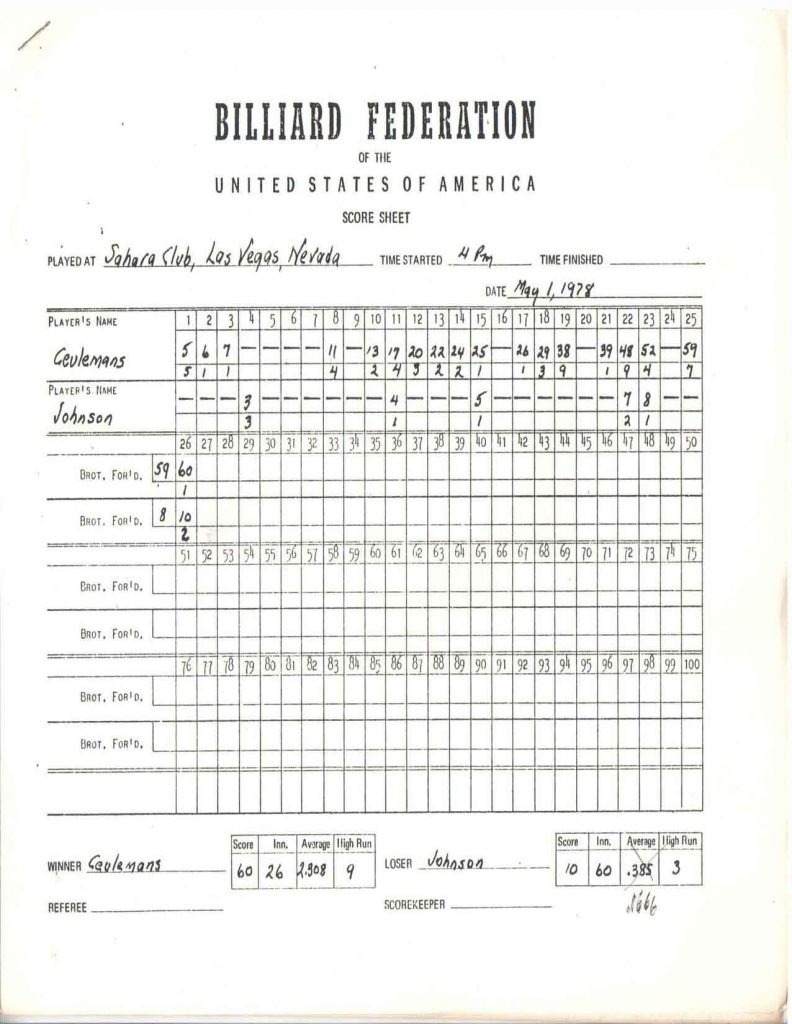2018/7 – Matches that changed our game (1/3)
Did you know that 3-cushion was invented in the USA? It’s no accident that the tournament of champions in August carries the name of Wayman C. McCreery, pioneer or even inventor of our game. We are so used to thinking of Europe as the center of gravity of billiards, with Asia as the rising power, that we could easily forget the crucial role played by the Americans, especially in the first half of the 20th century.
I’ll skip ahead a generation or two, to a true watershed moment in 1978. The American players had long lost their leading role in the game and Raymond Ceulemans had firmly established himself as the best player in the world. What, you may ask, could possibly be interesting about an exhibition match between an American hustler named Larry Johnson, better known as “Boston Shorty”, and the great Raymond Ceulemans? Why was this historic?
To understand the context of the match, played in Las Vegas, you need to realize that the American and the Belgian were experts at different games, even though they both called it 3-cushion. They almost played by different rules! Ceulemans was the undisputed king of league and tournament play. Boston Shorty played money games. A 3-cushion match for money, American pool hall style, had nothing to do with innings. Quite often, innings were not even kept; the win was all that mattered.
As a result of decades of money games, the American players were specialists in defense. And none was better at it than Boston Shorty. It was defense of a kind most of us in Europe have never even seen. Players were allowed to make no effort at all to score a point (if they felt their chance of scoring was too low), and to just gently hit the opponent’s ball to bring it to one end of the table and rest the cue ball 12 or 15 inches from the red, at the other end of the table. The opponent might answer with a similar shot, and this could go on for a while.
Today, that would be considered appalling behavior, bad sportsmanship. But if both players use that tactic and there’s no rule forbidding it, there’s nothing appalling about it. It’s simply a different game.
With that in mind, you can see where Boston Shorty was coming from. It’s difficult to really put him on an accurate average, because he spent most of his career playing matches where innings were not kept. Eyewitness reports suggest that he was probably an 0.850 – 0.900. A good player, but no Ceulemans. Even in 1978, Mr. 100 won most of his tournaments averaging 1.300 or better, and occasionally it was 1.500.
This is what Boston Shorty told a reporter, in the days leading up to his confrontation with Ceulemans:
“There’s a good chance I can’t beat that Belgian, he’s very strong. But I’ll tell you one thing: he’s never going to average over 1.000 against ME. I’ll show him some good American “oil”. The word oil, in this context, meant carotte, defense. One person who attended the match later said that Shorty offered Ceulemans to “make it a little more interesting”, in other words, to bet some money on the outcome.

A quick look at the picture of the score sheet will tell you that Ceulemans had a walk in the park. He made every ticky and bank shot in the book, Shorty’s defense looked like the French “Maginot Line” in 1940: built to stop tanks, pretty useless against airplanes. The hustler’s nightmare ended after 26 innings: 60 – 10. Ceulemans certainly didn’t average 1.000. He averaged 2.308.
I don’t want to make Larry Johnson the villain of this story. It’s fun that he had to eat his words: a good lesson for all billiard players, to never predict the outcome of your own matches. But it’s not Boston Shorty who was humiliated that day. It was ultra-defensive 3-cushion, the strategy, the game plan, that found its definitive Waterloo. Boston Shorty was inducted into the Hall of Fame of American Billiards, and rightly so. He was a great player. But the match was historic because offense took on defense, and defense was crushed. It was exposed for what it was: a bad strategy.
Was Raymond Ceulemans an all-out offensive player? Certainly not. He found a near-perfect balance between scoring and defending. A 3-cushion player who doesn’t know how to present his opponent with shitty positions is like a boxer who does not protect his face with his hands. You’re asking to get hurt. But if holding your hands in front of your face is your game plan, you are never going to win a fight. This 1978 match is the ultimate reminder that 3-cushion billiards is not about blocking your opponent’s path to the finish line. It’s about getting there first.